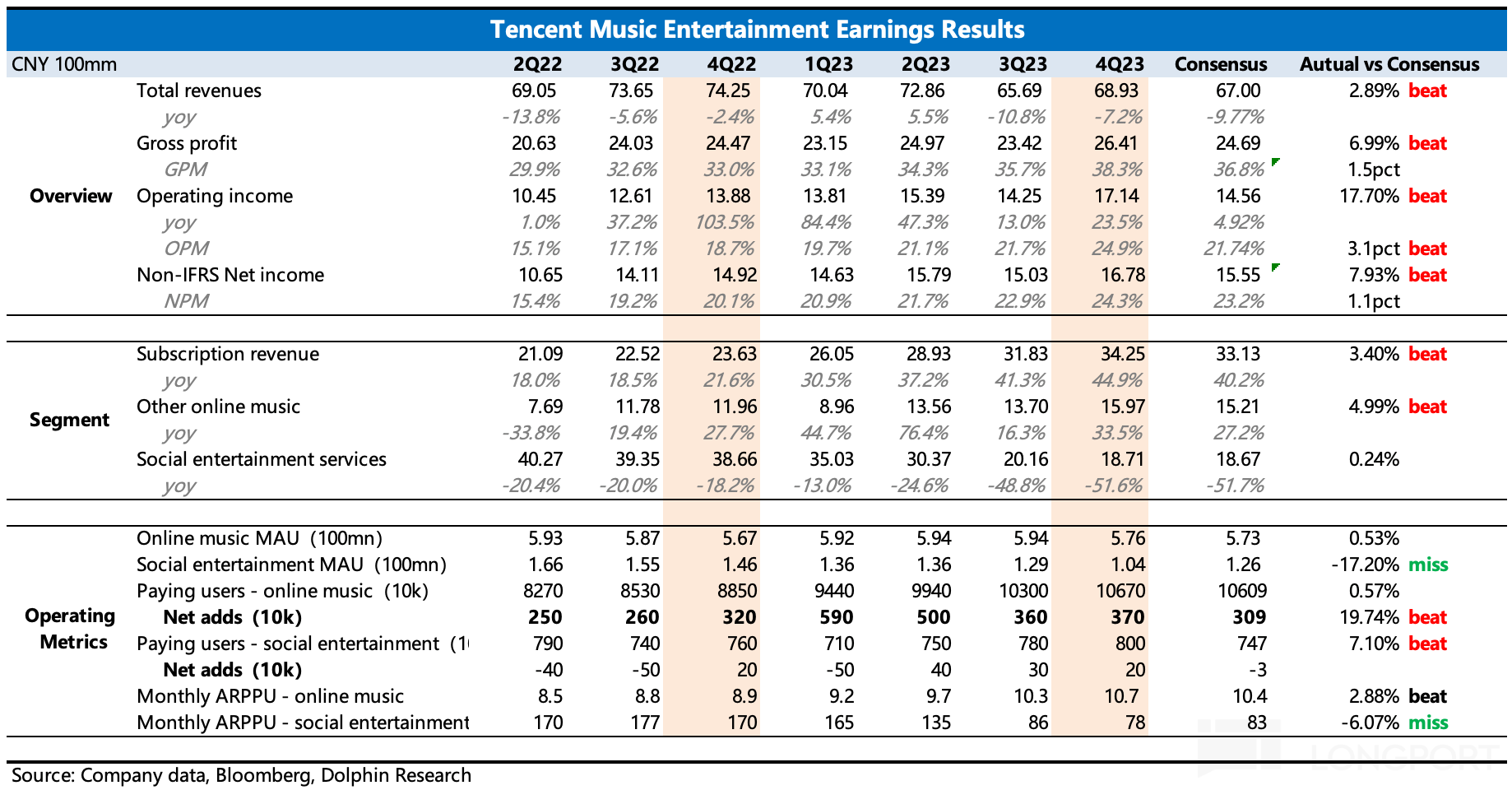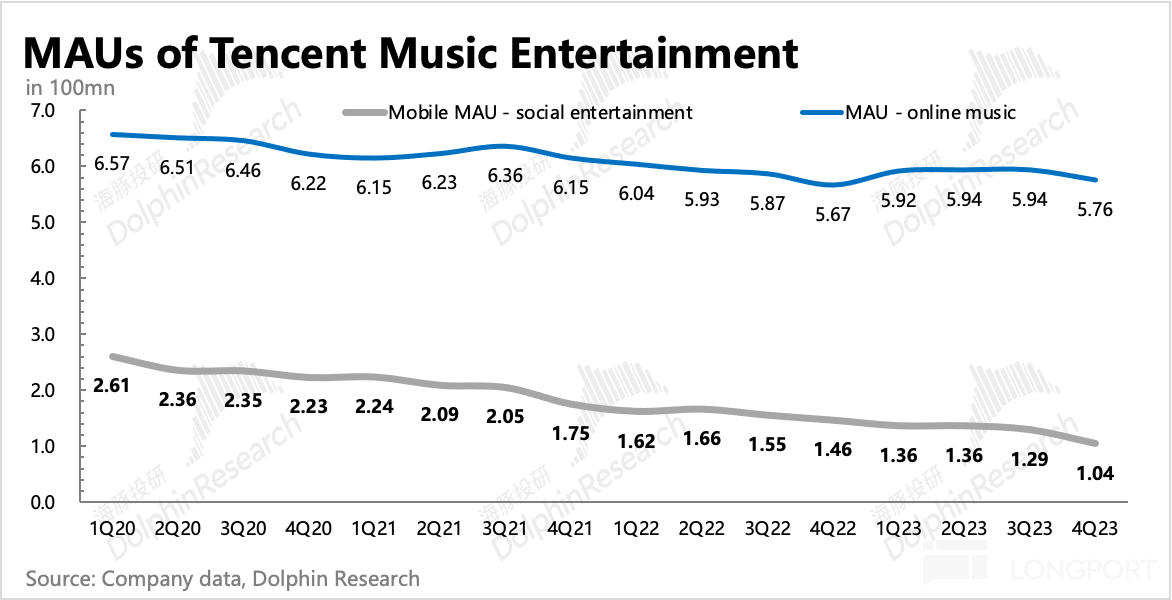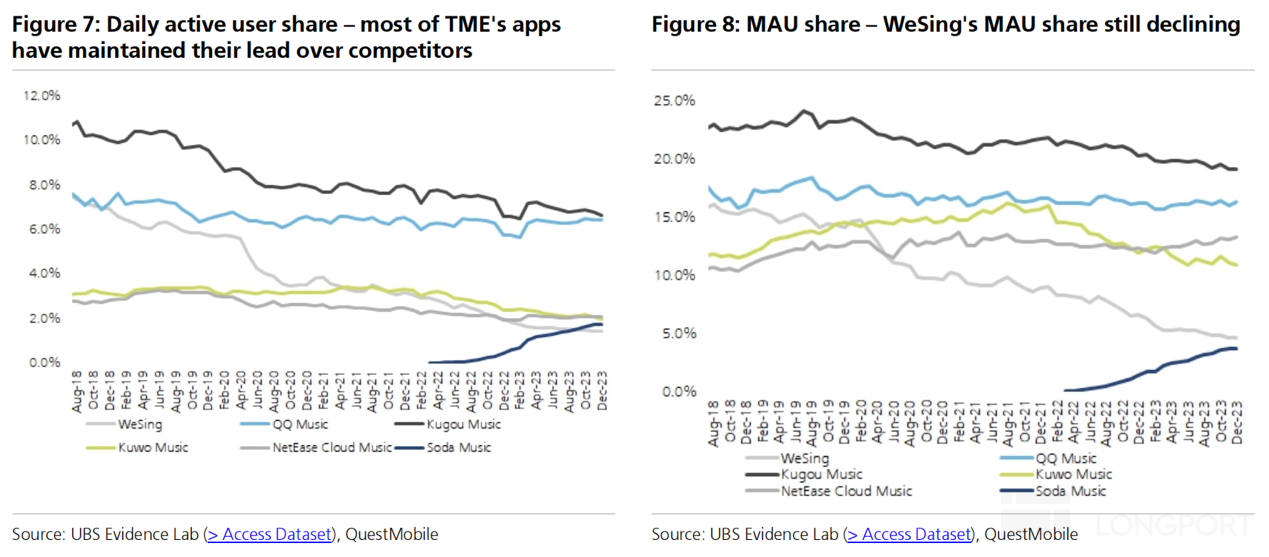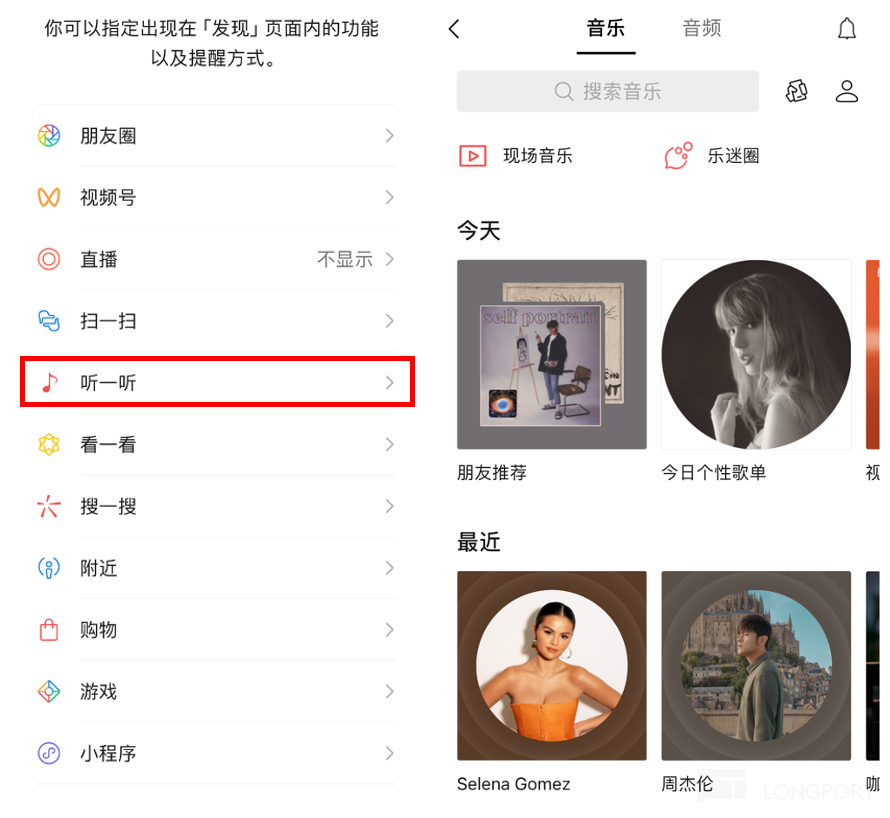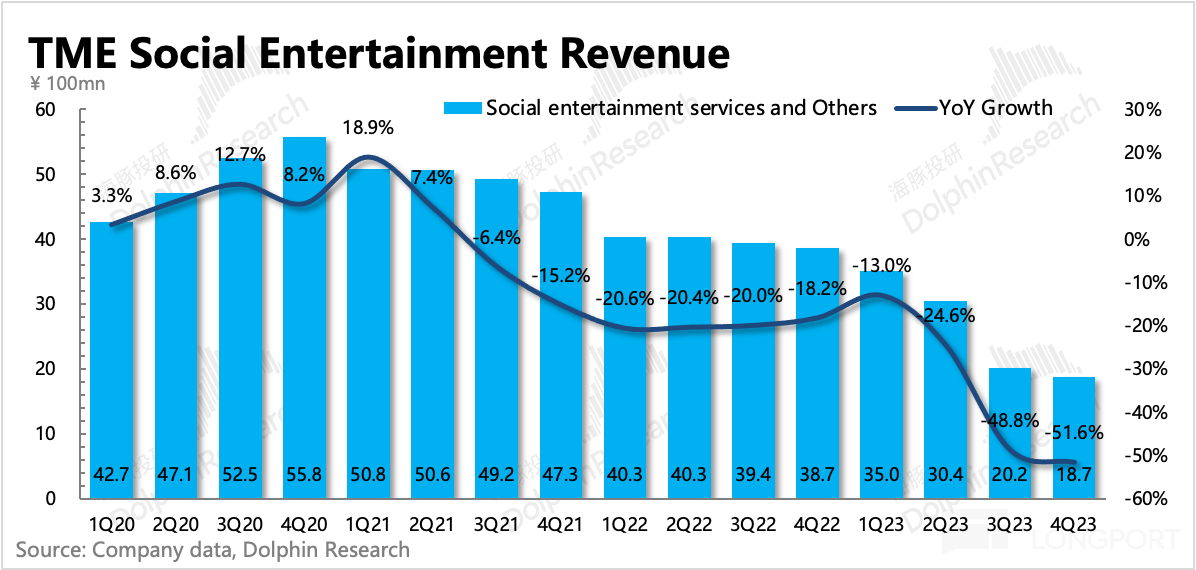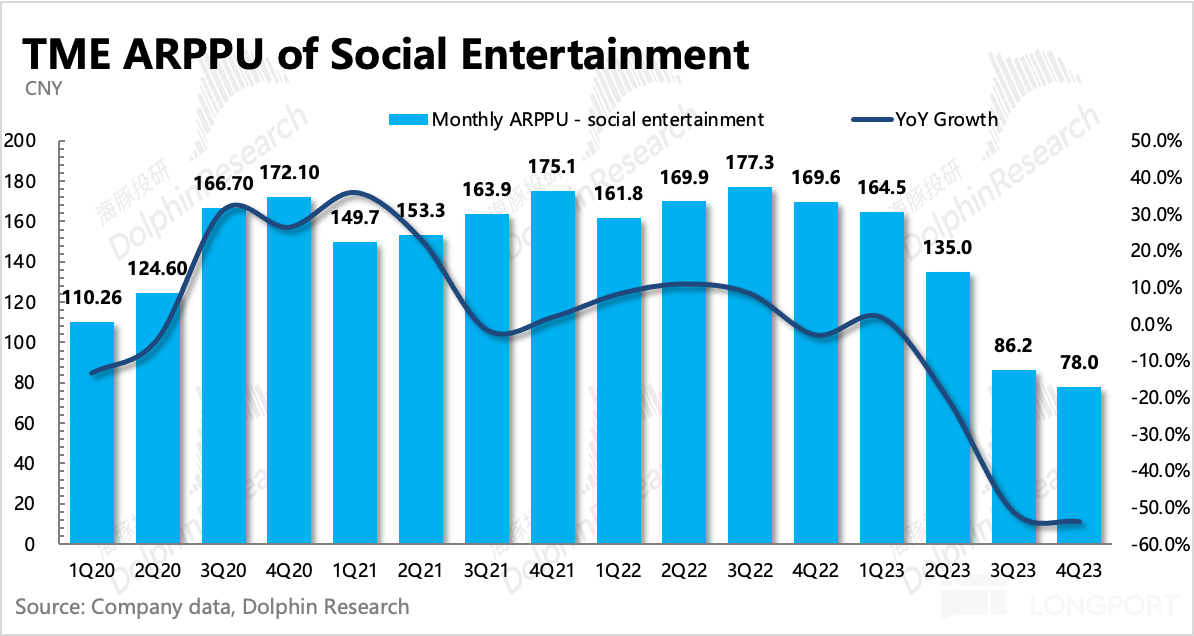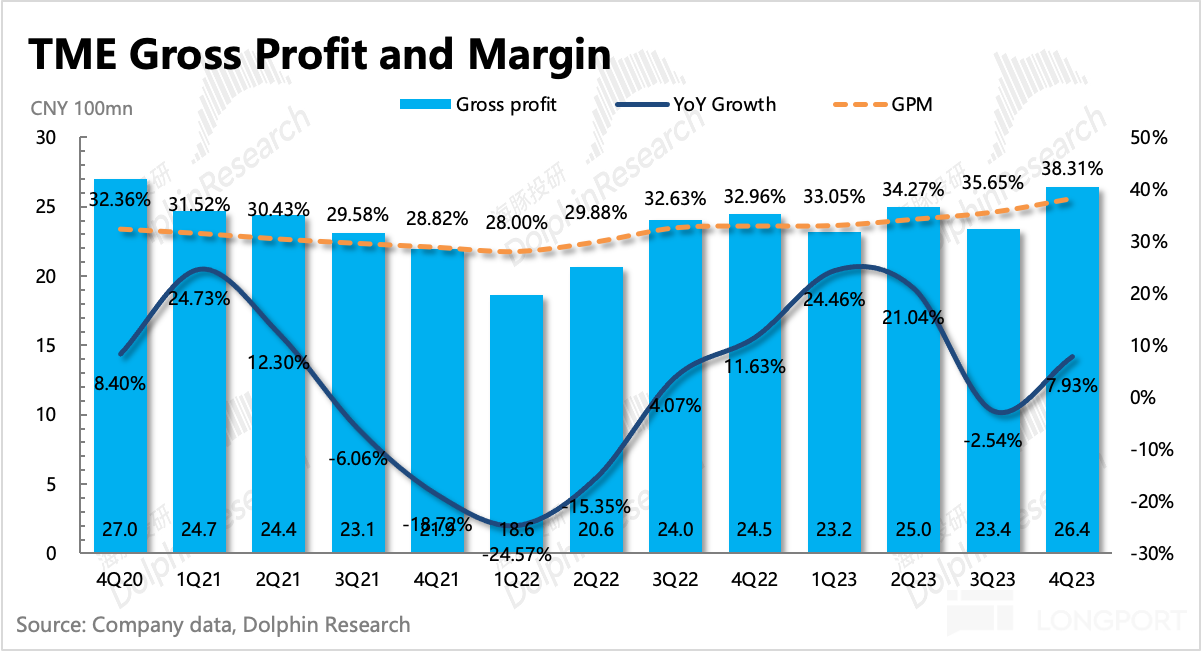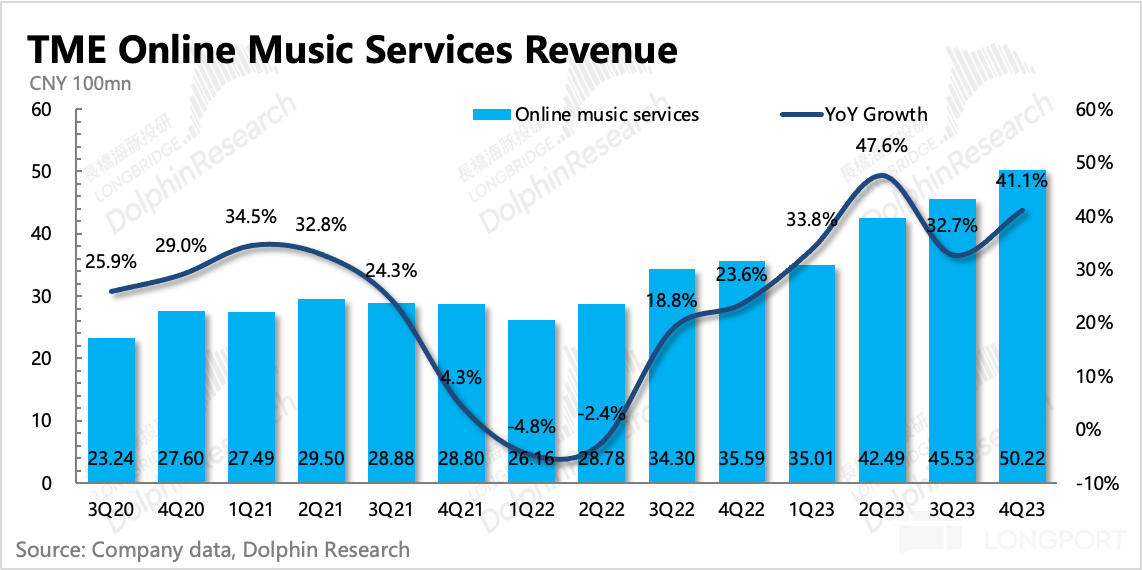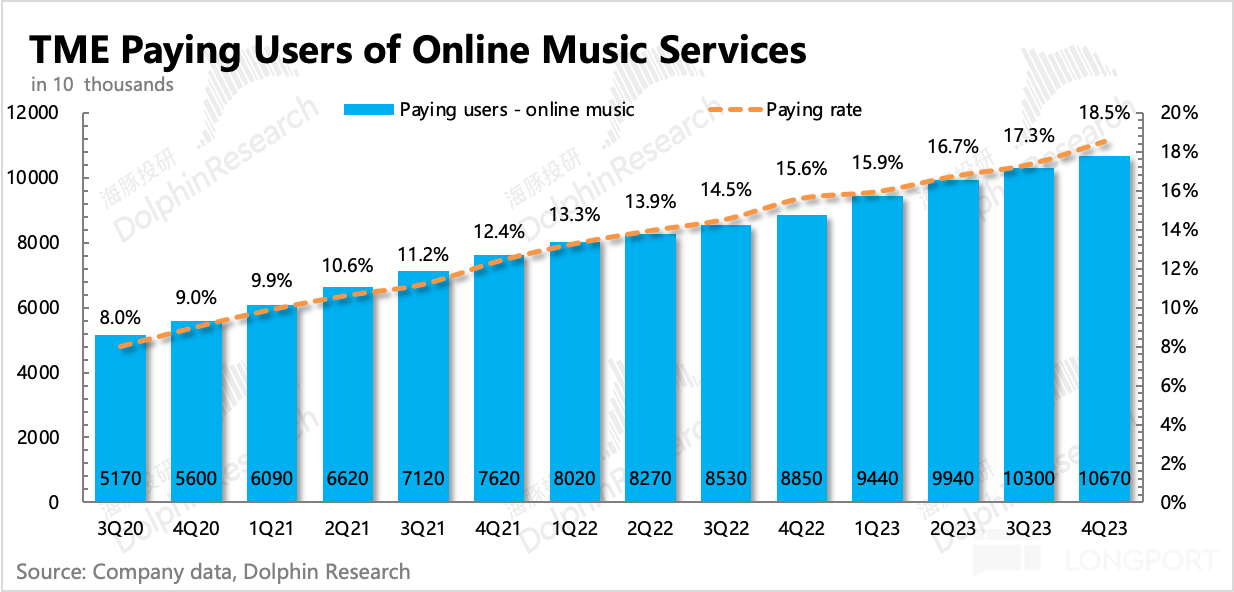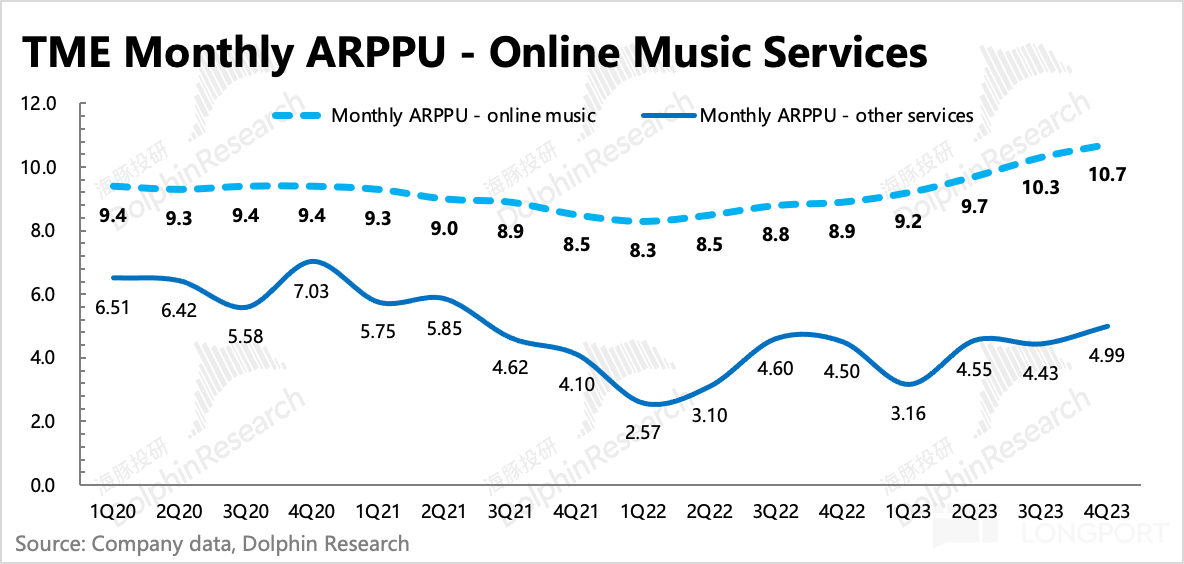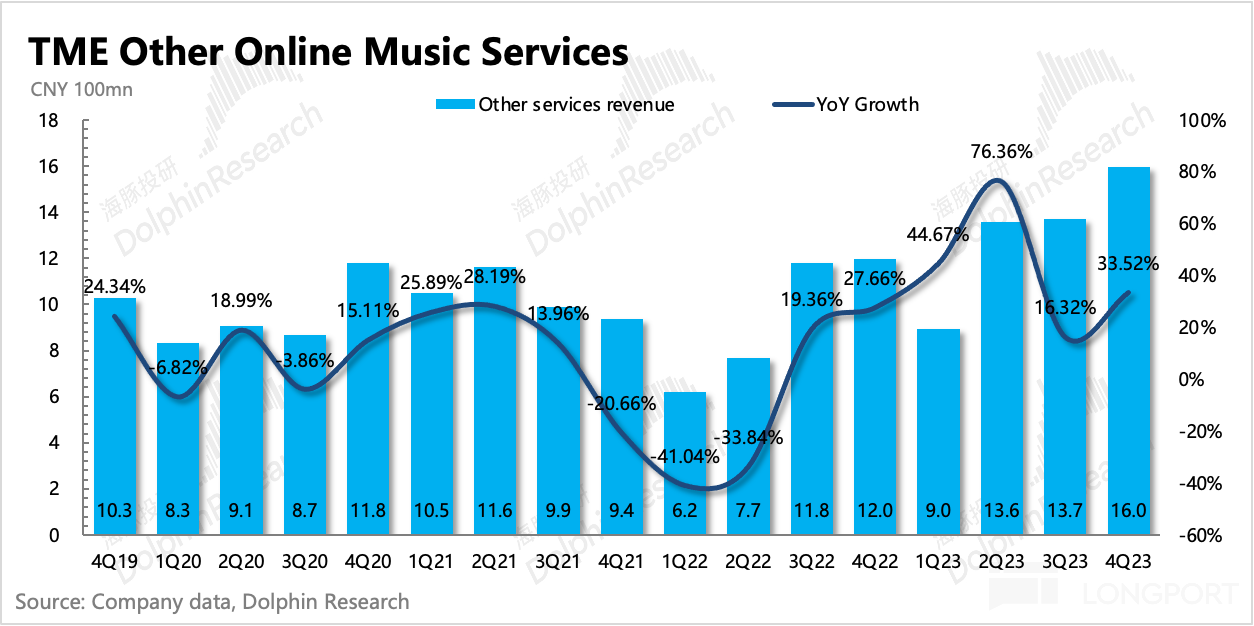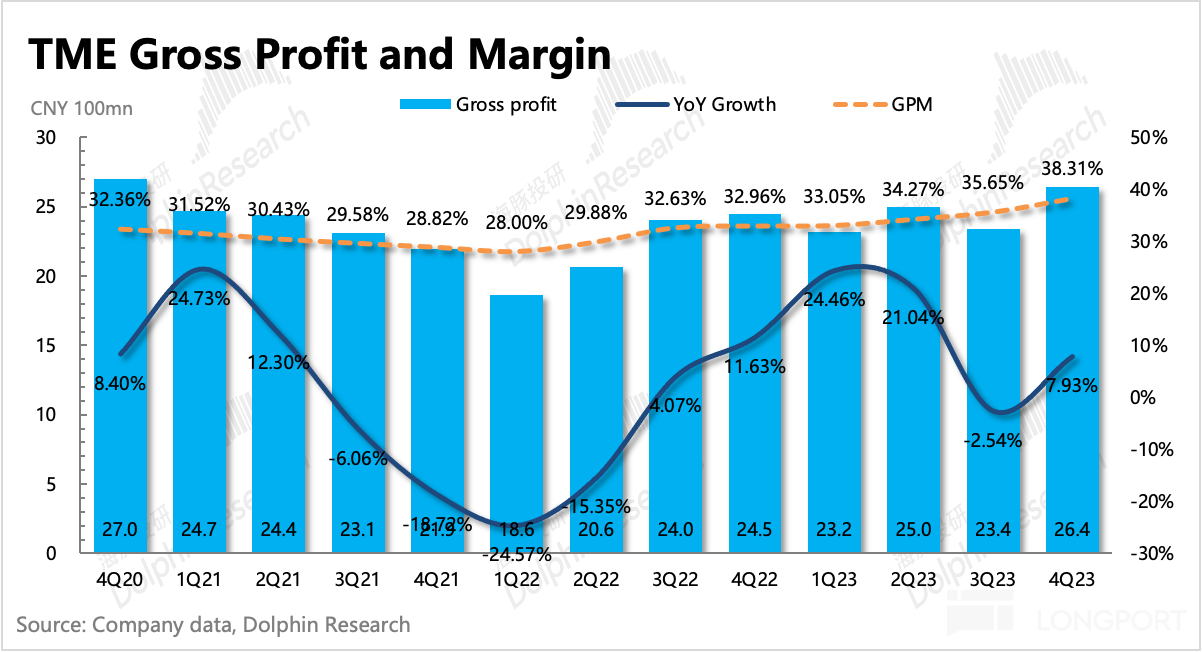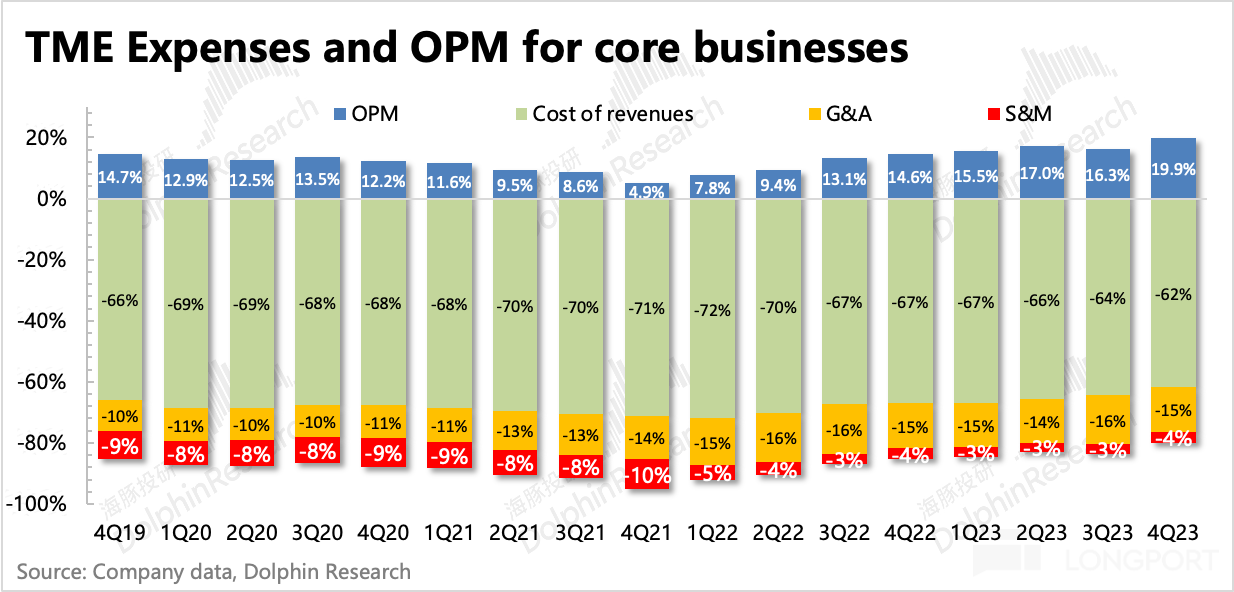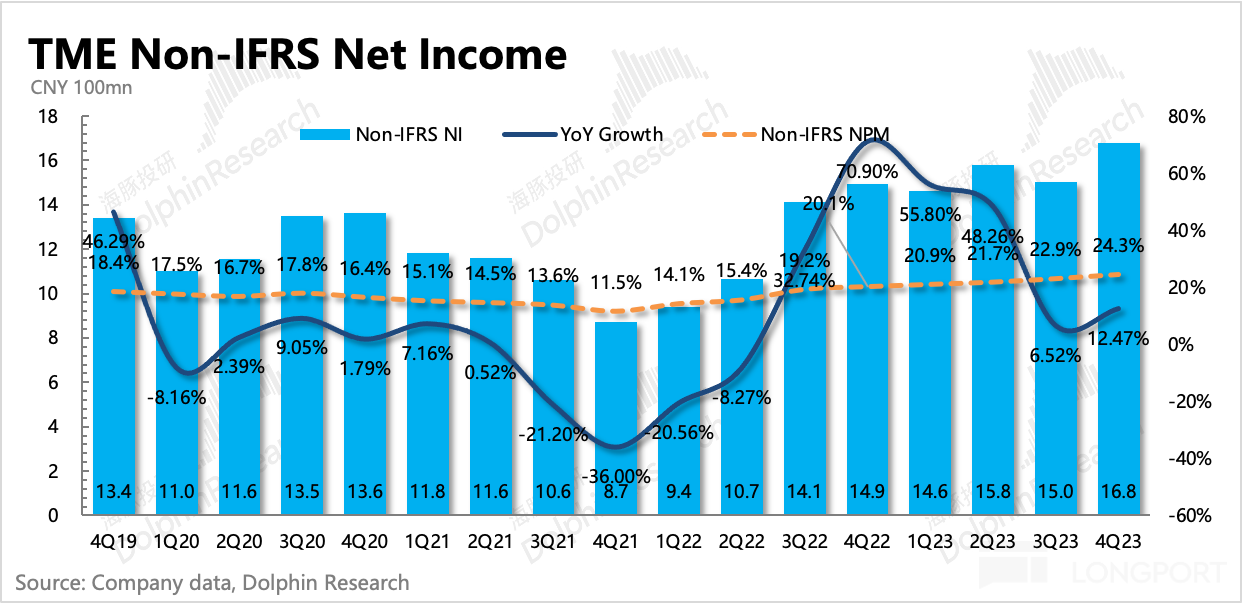
 Likes Received
Likes Received Posts
PostsTencent Music: Industry Leader with Built-In Buff, Uses Price Increases to Counter Cycles

After the Hong Kong stock market closed on March 19th Beijing time, Tencent Music.US released its financial report for the fourth quarter of 2023. Thanks to strong growth in its subscription business, the overall performance was decent. Revenue exceeded expectations, and with relatively stable cost and expenses, it drove an accelerated improvement in profits.
Here are some key points to note:
1. Negative Revenue Growth: Strong Subscriptions, Social Entertainment Still Struggling
In the fourth quarter, Tencent Music's total revenue continued to decline (-7.2%), still affected by adjustments in live streaming. However, this impact was already well anticipated since the company announced the adjustments in the middle of last year, and market attention has mainly shifted towards the development prospects of the music business itself.
In fact, Tencent Music's performance in the fourth quarter exceeded market expectations (-9%), benefiting from:
(1) A strong 45% growth in subscription business. Despite further reducing member discounts at the end of last year, the number of paying members continued to steadily increase. This essentially reflects Tencent Music's current solid market position and the essential nature of music listening for some users.
(2) In the music business, growth in licensing, digital albums, and advertising was also impressive, with a 33% year-on-year increase. Despite the significant impact on licensing business after exclusive rights were unbundled, the digital music market is relatively mature. Leveraging the strong traffic base of the Tencent ecosystem, Tencent Music still has the potential to gain advantages in music distribution (corresponding to digital album sales) and free users (corresponding to advertising revenue).
(3) Live streaming and karaoke businesses are still recovering from setbacks, with revenue halved in the fourth quarter due to active adjustments in response to competition in short videos and regulatory requirements. However, the number of paying users in social entertainment has been steadily increasing for three consecutive quarters, indicating the company's efforts to add more value-added services to meet core user needs and offset some of the impact of the live streaming business.
2. Seasonal Decline in Users, Limited Industry Competition, Potentially Affected by "Price Increases"
In the fourth quarter, the overall platform's monthly active users still experienced seasonal losses, decreasing by 18 million compared to the previous period. Although the market had already anticipated this based on third-party data, there may also be some reflection of the impact of "hidden price increases," especially for price-sensitive non-core users. The significant cancellation of discounts at the end of last year may continue to have some short-term effects on user numbers.
In terms of competition, Tencent Music's monopoly position remains stable for now. Cloud music has limited competitiveness, while ByteDance's Watermelon Music has been steadily increasing its monthly active users, mainly relying on traffic from Douyin. However, user awareness has not yet been fully cultivated, with average daily usage still only a few minutes.Tencent Music may have also noticed the bottleneck in the overall traffic pool. At the beginning of the year, WeChat and Tencent Video both strengthened the function of listening to music to assist in customer acquisition.
3. Stable Costs, Expenses Still Shrinking
Costs in the fourth quarter decreased by 15% year-on-year and remained flat quarter-on-quarter. Costs significantly decreased in the third and fourth quarters, mainly due to the impact of adjustments in the live streaming business, with reduced rewards leading to a simultaneous decrease in payments to broadcasters. However, as subscription business volume and prices rose in tandem, the proportion of copyright costs to revenue gradually decreased, ultimately reflected in a continuous improvement in gross profit margin. In the fourth quarter, the 38% gross profit margin has reached the company's medium to long-term target level (35%-40%).
However, Dolphin believes that under the premise of maintaining the platform's competitive advantage, there may still be room for further optimization of the gross profit margin. In addition to increasing the payment rate, reducing discounts, and enriching the benefits of high-level members to stimulate an increase in average user payments, copyright costs themselves can also be optimized through bargaining power in the industry chain, signing more favorable procurement contracts and profit-sharing ratios.
For example, for top labels (top 3), their market share in China is not as significant as in Europe and the United States, and in recent years, with the prevalence of independent music production, the market share of small and medium-sized music labels has increased. For Tencent Music, there is motivation to compress the fixed minimum costs of top labels, thereby optimizing the overall gross profit margin.
Sales and administrative expenses are still declining, but after more than a year of strong cost reduction and efficiency improvement, we expect the rate of decline in future expenses to slow down and return to growth.
Overall, with revenue expansion and expenditure contraction in the fourth quarter, the operating profit of the core main business reached 1.38 billion, a year-on-year increase of 27%, and the profit margin increased by 3 percentage points quarter-on-quarter, reaching 20%.
4. Repurchases are not a rigid indicator, depending on market value changes
In the fourth quarter, 9.5 million ADS shares were repurchased, consuming $70 million, at an average price of $7.4 per share. In the third and fourth quarters, a total of $175 million was repurchased. According to the announced repurchase plan of $500 million over 24 months at the beginning of the year, there is still $325 million in remaining quota, with a potential annual repurchase yield of 1-2%, which is not high. In addition, Tencent Music's repurchase is not a conventional rigid indicator, and the timing of repurchase is generally chosen based on changes in market value.
5. Overview of Detailed Financial Data

Dolphin's Viewpoint
As mentioned earlier, Tencent Music has the ability to continuously "raise prices" and expand the scope of the paywall over the past two years to convert more freemium users, fundamentally reflecting Tencent Music's solid leading position.Although there is still a drag from the live streaming business at present, the trend should show a significant slowdown this year after reducing the drag, and the overall business returning to growth is also worth looking forward to. Of course, whether the subscription business can maintain stable growth actually depends more on the changes in the competitive landscape of the digital music market, and is not significantly affected by other entertainment methods such as short videos. This is because in the core user base, there are differences in consumption scenarios between short videos and listening to music. Short videos cannot erode the duration of these scenarios, such as studying, working, commuting, etc. Live streaming, karaoke, and other social entertainment demand scenarios happen to have a higher overlap with short videos.
From the perspective of the industry's competitive landscape, although Cloud Music is the second largest platform in terms of user volume, it has not posed a threat to Tencent Music's leading position during the three-year period after the unbundling of exclusive copyrights. Moreover, with the strategic requirement of reducing costs and increasing efficiency within Cloud Music itself, competition with Tencent Music is also slowing down marginally.
However, Dolphin believes that Byte's soda music is worth paying attention to. Currently, the user volume is only about 1/10 of Tencent's, but the advantages of traffic diversion from Douyin and creating hit songs still need to be treated with caution. Of course, in the short term, the impact is limited. Not only is there a large gap in user volume compared to Tencent Music, but the average daily user duration is also relatively low, indicating that user awareness has not been fully established.
In addition, the significant "price increase" around December may require vigilance on the sustainability of the short-term impact on non-core user scale. Because it was implemented at the end of the year, the potential negative impact may not have been fully reflected in the Q4 performance. It is recommended to pay attention to the management's guidance and expectations for the first quarter of this year during the conference call.
In the last quarter's financial report, Dolphin mentioned that the investment logic change for Tencent Music came from the successful commercialization of the business model, and the continuously rising stock price since the third quarter represents that funds are continuously pricing in the reversal logic and the medium to long-term prospects of Tencent Music. Currently, the valuation corresponds to Dolphin's neutral expectations (USD 16-18 billion), which is not considered fully priced compared to the relatively optimistic medium to long-term prospects guided by the management (Dolphin estimates at USD 20-22 billion). However, compared to the return potential of other assets, the risk-return ratio of TME may be relatively average.
Detailed analysis is as follows:
I. Platform traffic seasonally declines, while the payment rate continues to rise
In the fourth quarter, Tencent Music's online music monthly active users dropped to 576 million compared to the previous month. Although there is a seasonal impact, looking at the trend over the past few years, the platform's traffic pool has not completely stabilized. The rectification of live streaming started in early June, and the overlap of the fourth quarter with the off-season accelerated the loss of 25 million users in the social entertainment businessFrom the third-party data perspective, although the user base of competitor Cloud Music is also declining, the decline is somewhat mitigated due to less reliance on live streaming and karaoke business compared to Tencent Music. Meanwhile, Byte's music platform is gaining momentum under the traffic diversion from Douyin, although the current scale and user engagement are lower than Tencent Music. Given Douyin's strong traffic advantage, it is necessary to pay attention to Byte's music platform's future actions.
In early February this year, possibly in response to the potential risk of user churn, Tencent Music deepened cooperation with its parent company by enhancing music features on WeChat and Tencent Video to assist in user acquisition. Dolphin will continue to monitor the effectiveness of this traffic diversion.
2. Live streaming and karaoke continue to drag down
In the fourth quarter, social entertainment revenue continued to decline by 52% year-on-year, reaching only 1.87 billion yuan, which is one-third of the peak period. Although the company mentioned that the negative impact was improving month by month in the previous quarter, it still significantly dragged down the group's performance. We expect a substantial decline this year, albeit with some convergence.
Under the adjustment of the live streaming business, the ARPPU of paying users in social entertainment continued to plummet to 78 yuan per month. However, by increasing payment points and enhancing user stickiness, the number of paying users increased against the trend.
3. Monopoly advantage determines pricing power
The pressure brought by the collapse of social entertainment will to some extent prompt the company to accelerate the release of the growth potential of digital music payments through a paywall strategy. At the same time, the revenue from digital albums and advertising in other online music segments is accelerating growth, especially under the high base of Jay Chou's album. The release of more advertising formats and inventory is the main driving factor for growthFurther breakdown shows that:
- Subscription revenue increased by 45% year-on-year, accelerating expansion with a rise in both volume and price. Among them, the number of paid users (+21% yoy) and the average payment per user (+20% yoy) saw a higher increase compared to the previous quarter.
At the end of last year in December, the company implemented another round of price adjustments, with a significant impact on user base in the short term. It is recommended to pay attention to the management's guidance on the first quarter subscription business for this year.


- Other online music services including digital copyright sales and advertising revenue, despite a high base, still achieved a 34% year-on-year growth in the fourth quarter, mainly driven by the release of advertising inventory.

IV. Gross profit margin meets standards, but there may still be room for improvement
Costs in the fourth quarter decreased by 15% year-on-year and remained flat quarter-on-quarter. Costs significantly decreased in the third and fourth quarters, mainly due to adjustments in the live streaming business, resulting in reduced tips and subsequently lower payouts to broadcasters. However, with the simultaneous increase in subscription business volume and price, the proportion of copyright costs to revenue gradually decreased, leading to a continuous improvement in gross profit margin. In the fourth quarter, it reached 38%, already meeting the company's medium to long-term target level (35%-40%).

However, Dolphin believes that while maintaining the platform's competitive advantage, there may still be room for further optimization of the gross profit margin. In addition to increasing the subscription rate, reducing discounts, and enriching the benefits of high-level members to stimulate an increase in average user payments, the copyright costs themselves can also be optimized through bargaining power in the industry chain, signing more favorable procurement contracts and profit-sharing ratios.
For example, for top labels (top 3), their market share in China is not as significant as in Europe and the United States, and in recent years, with the rise of independent music production, the market share of small and medium-sized music labels has been increasing. For Tencent Music, there is motivation to reduce the fixed minimum costs of top labels, thereby optimizing the overall gross profit margin.
Sales and administrative expenses are still declining in the fourth quarter, but after more than a year of strong cost reduction and efficiency improvement, we expect the rate of decline in subsequent expenses to slow down and eventually resume growth.
Finally, with revenue expansion and expenditure reduction, the operating profit of the main business reached 1.38 billion, and the profit margin level is approaching 20%If the impact of intangible asset amortization from acquisitions, equity incentives, and non-operating investment income is excluded, Tencent Music achieved a Non-IFRS net profit of 1.68 billion in the fourth quarter, a year-on-year increase of 12.5%. The difference between the growth rate of operating profit in the main business (+27% yoy) can mainly be attributed to the decrease in amortization on a year-on-year basis.
Dolphin Research on "Tencent Music" in the past year:
Financial Reports
- November 17, 2023: Conference Call "Plenty of Room for Music Subscriptions (Tencent Music 3Q23 Conference Call Summary)"
- November 14, 2023: Financial Report Review "Tencent Music: Hidden by the Shadow of Live Broadcasting"
- August 15, 2023: Conference Call "Adjustments in Live Broadcasting Expected to Stabilize by the End of the Third Quarter (Tencent Music 2Q23 Conference Call Summary)"
- August 15, 2023: Financial Report Review "Tencent Music: Business Adjustments, Continuing to Grind at the Bottom"
- March 22, 2023: Conference Call "No Major Issues in Performance Guidance, Just Overly Full Expectations (Tencent Music 4Q22 Conference Call Summary)"
- March 21, 2023: Financial Report Review "Tencent Music: Without Growth, Can 'Saving' Sustain the Big Dream of Music?"2022 年 11 月 16 日电话会《 Tencent Music: Open Source and Cost Reduction, Profit Margin Will Continue to Rise Next Year (3Q22 Conference Call Summary) 》
2022 年 11 月 15 日财报点评《 Tencent Music: "Purifying" Users, Squeezing out Profits, Everything Focuses on "Money" 》
2022 年 8 月 16 日电话会《 Tencent Music: Enriching Membership Privileges, Continuing to Promote Incentive Advertising (Conference Call Summary) 》
2022 年 8 月 16 日财报点评《 Tencent Music: Easing Performance Decline, But Signs of Recovery are Still Early 》
2022 年 5 月 17 日电话会《 The Impact of New Live Broadcasting Regulations Will Emerge Throughout the Year, Cost Reduction and Efficiency Improvement is One of This Year's Top Priorities (Tencent Music Conference Call) 》
2022 年 5 月 17 日财报点评《 Tencent Music: It's Still Early in the Spring, No Worries with Plenty of Grain 》
In-depth
2023 年 4 月 12 日《 TikTok and Tencent's Collaboration Outside the Arena, Is There a Solution to the Dead End of Entertainment Payment? 》
2023 年 1 月 6 日《 Pan-Entertainment "Good Start", Tencent, Bilibili, Whose Rebound is More Sustainable? 》
Risk Disclosure and Statement of this Article: Dolphin Research Disclaimer and General Disclosure
The copyright of this article belongs to the original author/organization.
The views expressed herein are solely those of the author and do not reflect the stance of the platform. The content is intended for investment reference purposes only and shall not be considered as investment advice. Please contact us if you have any questions or suggestions regarding the content services provided by the platform.

